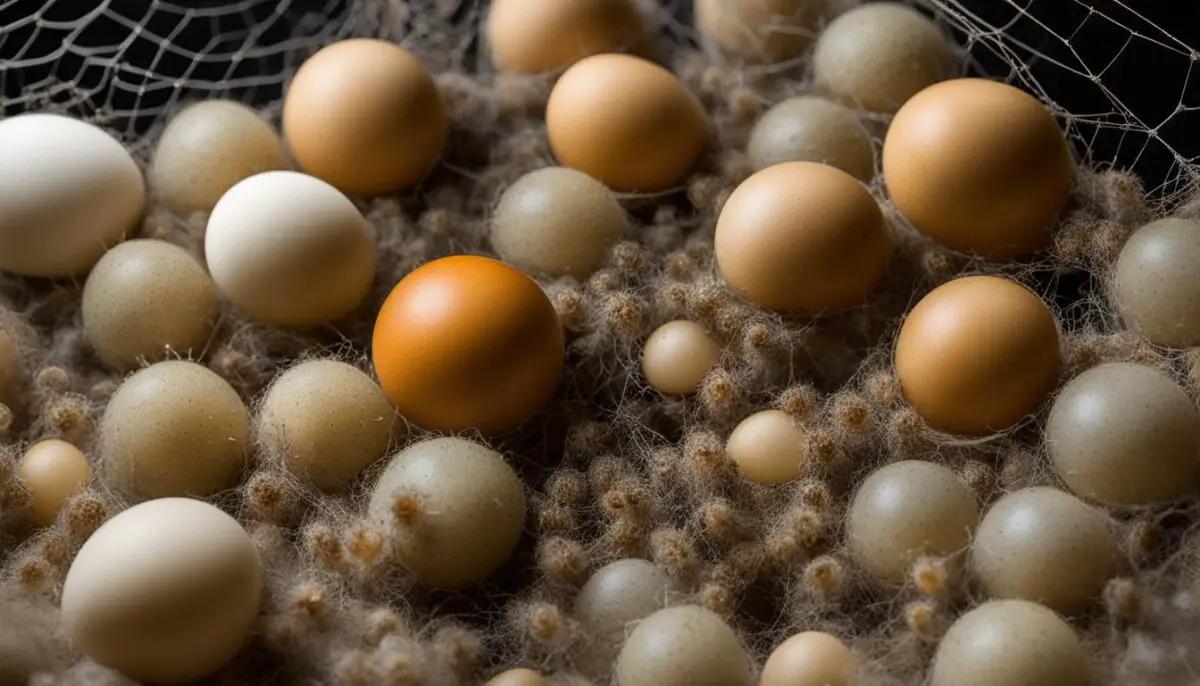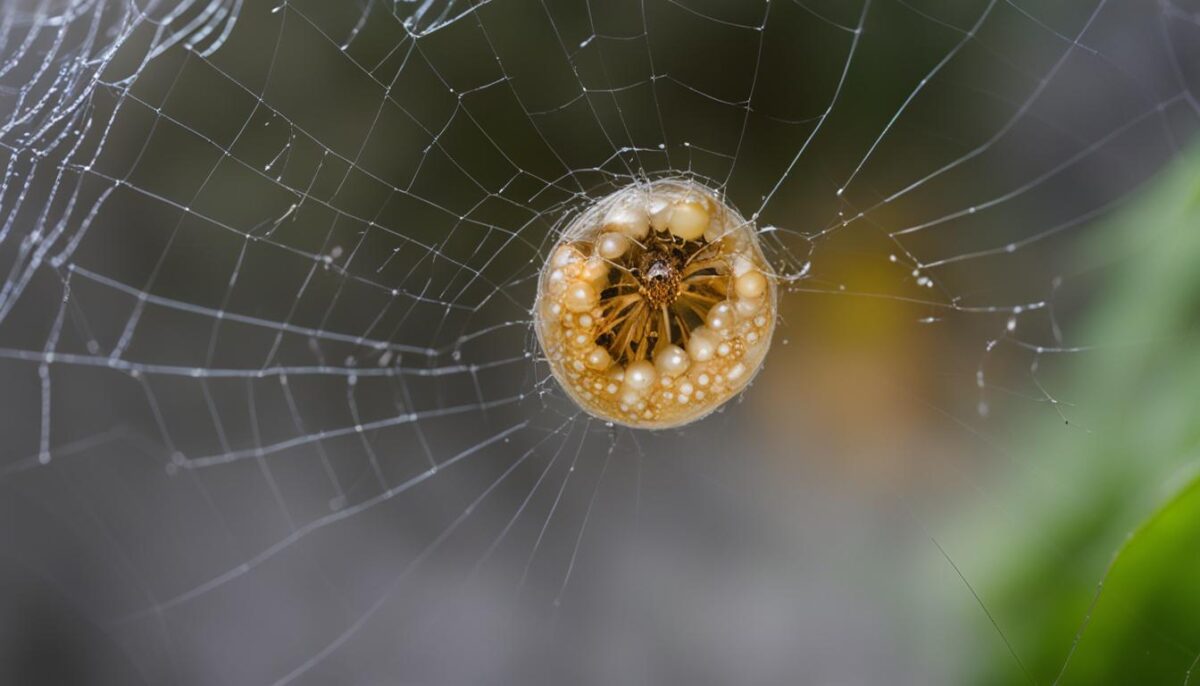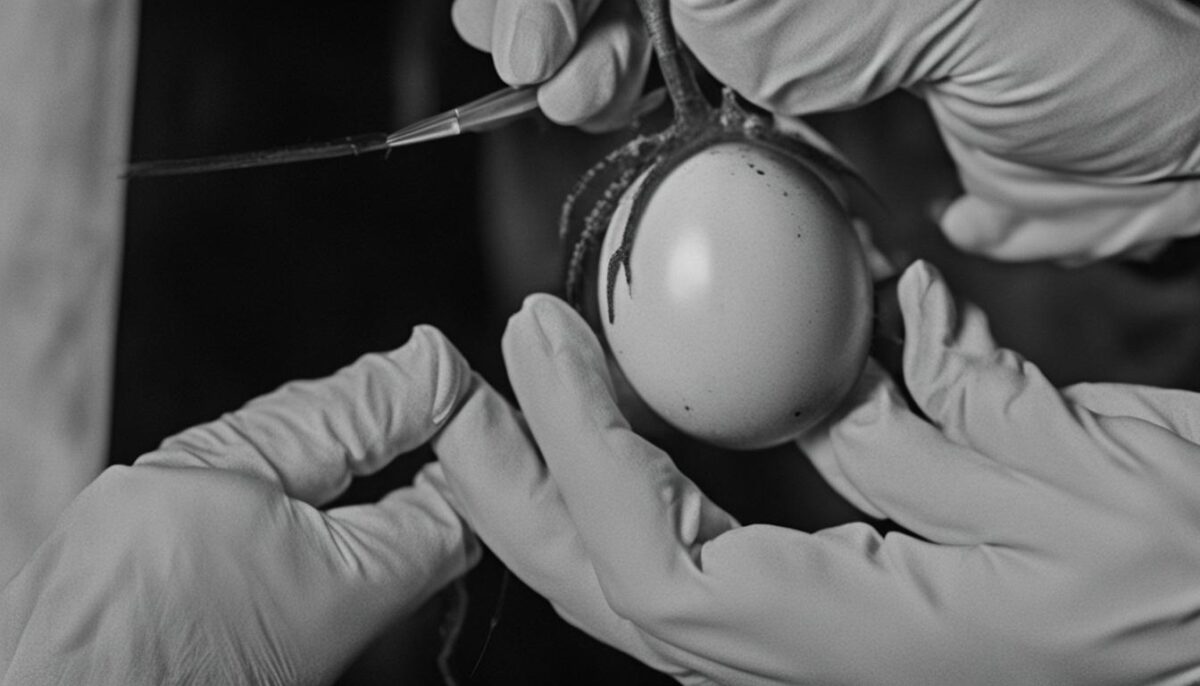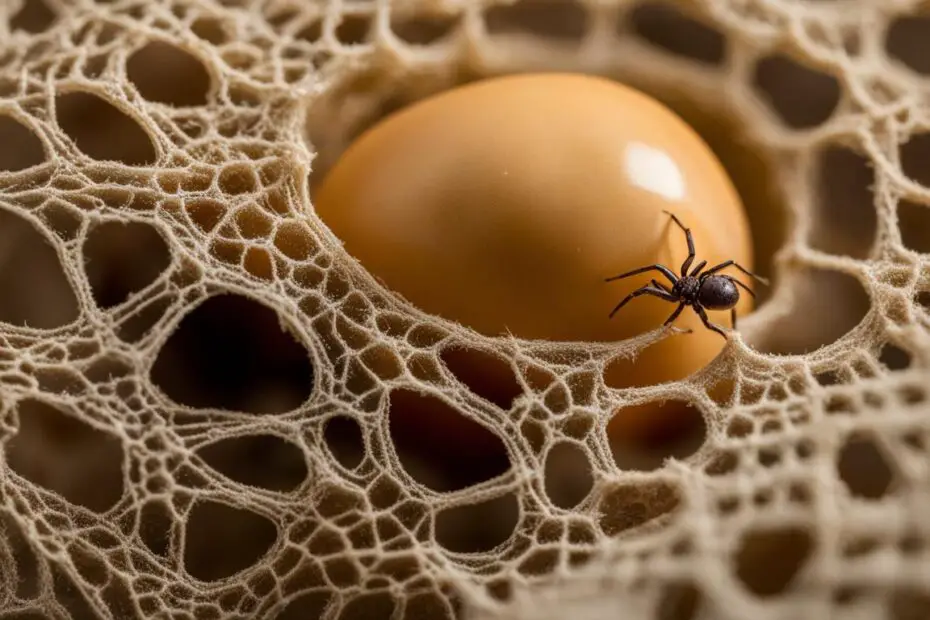Have you ever wondered how many spiders are in an egg sac? Spider reproduction is a fascinating process that involves the formation of egg sacs, each containing a different number of eggs. Understanding the spider life cycle and the development of these sacs can provide insights into the world of these incredible creatures.
Spider egg sacs come in various sizes, depending on the species and individual spider. From small sacs holding around 100 eggs to larger ones that can contain up to 2,000 eggs, the diversity in size is astonishing. Additionally, the different habitats in which spider egg sacs are found contribute to their unique characteristics.
Spider eggs take approximately 2 to 3 weeks to hatch, but this duration can vary depending on the species and environmental conditions. Once the spiderlings emerge, they spend time near the nest area before venturing out to establish their own territories.
Key Takeaways:
- Spider egg sacs can contain varying numbers of eggs, ranging from around 100 to as many as 2,000.
- The size of a spider egg sac is influenced by the species and its reproductive habits.
- Egg development typically takes 2 to 3 weeks, although this timeframe can differ depending on the species and environment.
- Spiderlings settle near the nest area for a period before dispersing to find their own territories.
- Understanding spider egg sacs can aid in spider identification and pest control efforts.
How Much Spiders are in an Egg Sac
Spider Egg Sac Size and Reproduction
Spider egg sacs come in different sizes depending on the species. While some egg sacs may hold around 100 eggs, others, like the brown widow and black widow spiders, can contain up to 2,000 eggs. The size of the egg sac plays a crucial role in determining the reproductive capacity of the spider. Larger egg sacs have the potential to produce more spiderlings, increasing the chances of survival for the species. how much spiders are in an egg sac
The size of the egg sac is influenced by the spider’s reproductive strategy and its ability to find suitable conditions for egg development. Female spiders carefully select and prepare the location for their egg sac, ensuring it is dark, damp, and secluded. These optimal conditions provide a safe environment for the eggs to develop and hatch. spider egg sac facts
Spider egg sacs are often round or oblong-shaped and covered in cream-colored webbing. This protective covering helps to camouflage the eggs and provides structural support for the sac. The webbing is often sticky and durable, helping to keep the eggs secure and protected from predators and environmental factors.
Understanding the size and reproductive patterns of spider egg sacs is essential in managing spider populations and preventing infestations. By identifying and removing these sacs, you can effectively control the spider population and minimize the presence of spider eggs in your home.
Table: Spider Egg Sac Sizes
| Spider Species | Egg Sac Size |
|---|---|
| Brown Widow | Up to 2,000 eggs |
| Black Widow | Up to 2,000 eggs |
| Common House Spider | Around 100 eggs |
| Wolf Spider | Around 200 eggs |
Spider Egg Development and Hatching
Spider eggs go through a fascinating journey from development to hatching. The time it takes for spider eggs to hatch varies depending on the species and environmental conditions. On average, spider eggs take about 2 to 3 weeks to hatch.
During the incubation period, spider mothers may display different behaviors. Some spiders actively protect their egg sacs until the spiderlings emerge, while others attach the sacs to their webs or structures and leave them unattended. The level of parental care varies among spider species. spider egg sac size
When spiderlings hatch, they are typically pale in color and very small. They quickly spin a dragline upon emerging, which helps them disperse and find suitable habitats. These young spiderlings settle near the nest area for several weeks before venturing out to establish their own territories.
| Spider Species | Average Incubation Period |
|---|---|
| Garden Spiders | 10-14 days |
| Wolf Spiders | 10-21 days |
| Jumping Spiders | 14-28 days |
Table: Average incubation period for common spider species
Spiderlings undergo multiple molts as they grow into adult spiders. This molting process allows them to shed their exoskeleton and develop more mature features. Once they reach adulthood, these spiders will reproduce and continue the cycle of spider egg development and hatching.
Spider Egg Hatching Tips
- Provide a suitable environment for spider eggs, such as a warm and humid space, to increase the chances of successful hatching.
- Avoid disturbing spider egg sacs during the incubation period, as this can disrupt the hatching process.
- If you find spider egg sacs indoors and wish to prevent hatching, consider gently removing the sacs and disposing of them in an outdoor area away from your home.
“Spider eggs usually take about 2 to 3 weeks to hatch.”

Identifying Spider Eggs
When it comes to identifying spider eggs, there are a few key characteristics to look out for. Spider eggs are often small and round, ranging in color from white to cream-colored. They are typically found inside silk egg sacs that are made by the mother spider as a form of protection and incubation. These sacs can vary in shape, but they are commonly round or oblong-shaped and covered in cream-colored webbing. spider egg sac habitat
Some spider egg sacs may have spikes or bumps, such as the sacs of brown widow and black widow spiders. These distinctive features can help in identifying the species of spider. When searching for spider eggs, keep an eye out for webs with small sacs of cream-colored webbing. The presence of spiderlings crawling around the sac is also a clear sign of a nearby egg sac.
Spider egg sacs come in a variety of shapes and sizes, but they are generally small and easy to miss if you’re not actively looking for them. Taking the time to familiarize yourself with the appearance of spider egg sacs can help you identify and remove them from your home or garden more effectively.
Table: Spider Egg Sac Appearance
| Spider Species | Egg Sac Appearance |
|---|---|
| Brown Widow Spider | Round or oblong-shaped sacs covered in cream-colored webbing, may have spikes or bumps |
| Black Widow Spider | Round or oblong-shaped sacs covered in cream-colored webbing, may have spikes or bumps |
| Other Spider Species | Small, round sacs with cream-colored webbing |
Knowing how to identify spider egg sacs is crucial for effective pest control. By recognizing the appearance of these sacs, you can take appropriate action to remove or prevent spider infestations. Regularly inspecting your property for the presence of spider eggs can help you maintain a spider-free environment.
Note: The image above is for illustrative purposes only and may not depict the exact appearance of spider egg sacs. Please refer to the description provided for accurate identification.
Spider Egg Removal and Prevention
If you’ve discovered spider eggs or egg sacs in your home, it’s important to take action to remove them and prevent further infestations. Here are some effective methods for spider egg removal and prevention:
Physical Removal
To physically remove spider eggs, you can use a broom or vacuum cleaner. When using a vacuum, be sure to dispose of the bag and contents, including the eggs, in a sealed plastic bag. This will prevent any potential hatchlings from escaping and creating a new infestation. Additionally, glue traps can also be placed in areas where spider eggs are commonly found to capture spiders and their eggs.
Maintain a Clean Environment
Preventing spider egg sacs involves reducing clutter indoors and outdoors. Regularly inspect and clear areas where spider webs and eggs are present, such as attics, basements, and corners with clutter. By eliminating potential nesting sites, you can discourage spiders from laying their eggs in your home. Keeping your living space clean and free of debris will make it less attractive to spiders.
Professional Pest Control Services
If your spider egg infestation persists despite your efforts, it may be necessary to seek professional pest control services. Pest control professionals can identify the species of spiders, locate egg sacs, and implement effective control measures. They have the knowledge and expertise to eliminate spiders and their egg sacs safely, providing long-term solutions to prevent further infestations.
| Spider Egg Removal Methods | Effectiveness |
|---|---|
| Physical removal with broom or vacuum | High |
| Glue traps | Medium |
| Regular cleaning and clutter reduction | High |
| Professional pest control services | High |
By utilizing these spider egg removal and prevention methods, you can effectively control spider populations and minimize the presence of spider egg sacs in your home. Remember to maintain a clean environment, physically remove egg sacs, and seek professional assistance if needed. With a proactive approach, you can keep your home spider-free and enjoy a pest-free living space.
Spider Egg Predators and Survival Rates
In the wild, spider eggs face numerous predators and environmental challenges that significantly impact their survival rates. Many eggs are preyed upon by other insects, spiders, birds, and small animals, while others may not survive due to unfavorable conditions such as extreme temperatures or lack of food. As a result, the overall survival rate for spider eggs in their natural habitat is relatively low.
However, in controlled environments or captivity, spider eggs have a higher chance of survival. With proper care and protection, the survival rate for spider eggs can be as high as 90% or more. This is mainly because the eggs are shielded from natural predators and provided with optimal conditions for hatching and development.
Weak or slow-growing spiderlings that may struggle to survive in the wild can thrive in captivity, reaching adulthood and contributing to the spider population. This higher survival rate in controlled settings highlights the importance of conservation efforts to preserve and protect spider species, especially those that are endangered or at risk.
While spider egg predators play a crucial role in regulating spider populations and maintaining ecosystem balance, their impact on survival rates should be considered when studying spider reproductive patterns and population dynamics.
Spider Egg Habits and Adaptation
Spider egg-laying habits play a crucial role in their survival and adaptation to various environments. Different spider species have distinct behaviors when it comes to selecting suitable locations for laying their eggs. These habits allow spiders to adapt to different conditions and increase the chances of successful reproduction.
Some spiders lay their eggs in a continuous and predictable pattern throughout the year, adapting to the conditions and climate found in homes. These spiders are known as house spiders and tend to create nests in secluded areas that are undisturbed, such as attics, basements, and corners with clutter. By finding shelter in human dwellings, they can take advantage of the stable temperature and protection from predators.
On the other hand, outdoor spiders have adapted to thrive in natural environments. They choose specific locations to build their nests, such as woodpiles, building overhangs, and under stones. These areas provide ample prey opportunities and protection from adverse weather conditions. Outdoor spiders play a vital role in maintaining the ecological balance by controlling the populations of insects, birds, and other small animals.
Spider Reproduction Patterns
Spider reproduction patterns also contribute to their adaptation and survival. Female spiders typically produce multiple egg sacs throughout their lifetime, ensuring the continuity of their species. Each egg sac can contain hundreds or even thousands of eggs. This high reproductive output compensates for the low survival rate of spider eggs in the wild.
After the eggs are laid, spiderlings develop within the egg sacs and hatch after a certain period. Upon emerging, these pale-colored spiderlings quickly disperse to find their own territories. This behavior prevents overcrowding and competition among siblings, increasing their chances of survival. Through this dispersal, spiders can colonize new areas and adapt to changing environments.
It is fascinating to observe how spiders have evolved and adapted their egg-laying habits and reproductive patterns to ensure the survival of their species. By understanding these habits and patterns, we can gain valuable insights into the remarkable adaptability of these fascinating creatures.

What to Do If You Find Spider Eggs
Discovering spider eggs or egg sacs in your home can be unsettling, but there are several effective methods for dealing with them. Whether you prefer a DIY approach or seek professional help, it’s important to take action to ensure the eggs do not hatch and lead to a potential infestation. Here are some strategies for spider egg control and nest treatment:
- Vacuum or Sweep: One of the easiest ways to remove spider eggs is by vacuuming or sweeping them up. Be sure to dispose of the collected eggs in a sealed plastic bag to prevent any chance of hatching or reinfestation.
- Boiling Water: If you want to eradicate spider eggs without using chemicals, pouring boiling water on the nests can be effective. This method helps destroy the eggs and any attached webbing, reducing the chances of survival.
- Physical Removal: For non-venomous spiders, you can simply swat them with a fly swatter or trap them using a jar or cup. Collect any visible egg sacs in a plastic bag and dispose of them properly.
- Chemical Solutions: Essential oils, such as peppermint or tea tree oil, can act as natural deterrents for spiders. Mix a few drops of oil with water in a spray bottle and apply the solution to areas where egg sacs are present. Additionally, bleach diluted with water can be used to kill spider eggs and spiderlings.
Remember, when dealing with spider eggs, it is important to exercise caution. Some spider species can be venomous and should only be handled by trained professionals.
If you’re unsure about how to handle spider eggs or want to ensure thorough removal, it is recommended to seek the assistance of professional pest control services. These experts have the knowledge, experience, and tools to identify and treat spider egg infestations effectively.
Table: Pros and Cons of Spider Egg Removal Methods
| Methods | Pros | Cons |
|---|---|---|
| Vacuum or Sweep | Easy and inexpensive | Possibility of eggs hatching if not properly disposed |
| Boiling Water | Chemical-free method | Requires caution to avoid burns |
| Physical Removal | Immediate control | Risk of accidental spider bites |
| Chemical Solutions | Effective in deterring spiders | Some solutions may have a strong scent |
| Professional Pest Control | Expert knowledge and comprehensive treatment | Costs associated with professional services |

Summary:
When you come across spider eggs or egg sacs, it’s crucial to take action to prevent hatching and potential infestations. Vacuuming or sweeping the eggs, pouring boiling water on the nests, or physically removing them are effective DIY methods. You can also consider using chemical solutions, such as essential oils or diluted bleach. However, if you’re unsure or dealing with venomous spiders, it’s best to seek professional pest control services. They can safely and effectively handle spider egg removal, ensuring your home remains free from these arachnid invaders.
Spider Egg Infestation Prevention
Preventing spider egg infestations requires proactive measures and the use of effective spider control measures and repellents. By implementing these strategies, you can minimize the presence of spider egg sacs in your home and maintain a spider-free environment. Here are some key tips to help you prevent spider infestations:
- Keep your home clean and clutter-free: Regularly clean and declutter both indoors and outdoors to minimize hiding places for spiders. Vacuum and sweep regularly, paying special attention to corners, crevices, and areas where spider webs are commonly found.
- Seal entry points: Inspect your home for openings and gaps that spiders can use to gain entry. Seal cracks in walls, windows, and doors with weatherstripping or caulk to prevent spiders from entering your living space.
- Remove outdoor debris: Clear leaves, woodpiles, and other debris from around your home’s exterior. These areas provide ideal hiding spots and breeding grounds for spiders. Regularly trim vegetation near your home to create a clear perimeter.
- Use spider repellents: Apply spider repellents to areas where spiders tend to gather, such as windowsills, doorways, and baseboards. Natural repellents like peppermint oil or vinegar can be effective in deterring spiders from entering your home.
- Install screens: Use window screens and door sweeps to prevent spiders from entering your home through gaps in doors and windows.
“Preventing spider infestations involves maintaining a clean and clutter-free environment, sealing entry points, and using effective spider repellents.”
By following these spider control measures and using spider repellents, you can significantly reduce the risk of spider egg infestations in your home. However, if the problem persists or if you have a severe infestation, it is advisable to seek professional pest control services for effective spider extermination and long-term prevention.

Spider Egg Infestation Prevention – Quick Tips:
- Keep your home clean and clutter-free.
- Seal entry points to prevent spiders from entering your home.
- Remove outdoor debris and trim vegetation near your home.
- Use spider repellents, such as peppermint oil or vinegar.
- Install screens on windows and doors to keep spiders out.
By implementing these preventative measures, you can create a spider-free environment in your home and minimize the presence of spider egg sacs. Remember to regularly inspect your home and take action at the first signs of a spider infestation to prevent eggs from hatching and reproducing.
Professional Spider Egg Removal and Pest Control Services
When faced with persistent spider infestations and the presence of spider egg sacs in your home, it may be necessary to seek the assistance of professional pest control services. These experts have the knowledge and expertise to identify the species of spiders, locate egg sacs, and implement effective control measures to eliminate spiders and prevent further infestations.
Pinnacle Pest Control is a reliable provider of professional spider control services. Their team of trained technicians understands the behavior and habits of different spider species, allowing them to develop targeted strategies for effective extermination. They use proven methods and environmentally-friendly solutions to ensure the safety of you and your family while effectively eliminating spiders and their egg sacs from your property.
By engaging professional pest control services, you can save time and effort in dealing with spider infestations. These experts have access to specialized tools and equipment that enable them to reach and treat areas that may be difficult for homeowners to access. They can also provide valuable advice on preventing future infestations, helping you maintain a spider-free environment in the long term.

Benefits of Professional Spider Control Services
- Expert knowledge and experience in identifying spider species and their nesting habits.
- Safe and effective removal of spider egg sacs, preventing the hatching and proliferation of spiders.
- Use of environmentally-friendly pest control methods to minimize the impact on the surrounding ecosystem.
- Access to specialized tools and equipment for thorough treatment of infested areas.
- Advice and recommendations for preventing future spider infestations.
Don’t let spider egg sacs and infestations take over your home. Trust the professionals at Pinnacle Pest Control for reliable and efficient spider extermination. With their expertise, you can enjoy a spider-free environment and peace of mind.
Conclusion
In conclusion, spider egg sacs can contain a varying number of eggs, with some sacs holding up to 2,000 eggs. The eggs typically hatch in 2 to 3 weeks, and the spiderlings disperse to establish their own territories. To effectively deal with spider eggs, it is important to physically remove them, use traps, and maintain a clean environment.
Preventing spider egg sacs involves reducing clutter, regularly inspecting and clearing areas where spiders and their webs are present, and employing professional pest control services if necessary. By implementing these measures, you can successfully control spider populations and minimize the presence of spider egg sacs in your home.
If spider eggs and infestations persist despite your efforts, seeking professional pest control services, such as the reliable and environmentally-friendly solutions offered by Pinnacle Pest Control, can provide effective solutions for eliminating spiders and preventing further infestations.
FAQ
How many spiders are in an egg sac?
The number of spiders in an egg sac can vary depending on the species. Some sacs may hold around 100 eggs, while others, like brown widow and black widow spiders, can contain up to 2,000 eggs.
What is the size of a spider egg sac?
Spider egg sacs come in different sizes depending on the species. They are often round or oblong-shaped and covered in cream-colored webbing.
How long does it take for spider eggs to hatch?
Spider eggs typically hatch in 2 to 3 weeks, although the exact duration can vary depending on the species and season.
How do I identify spider eggs?
Spider eggs are often small, round, and white or cream-colored. They are usually found inside silk egg sacs made by the mother spider.
How can I remove spider eggs and prevent infestations?
Spider eggs can be removed by using a broom, vacuum cleaner, or glue traps. To prevent infestations, it is important to reduce clutter, regularly clean areas where spiders are likely to nest, and employ professional pest control services if necessary.
What are the survival rates of spider eggs?
In the wild, spider egg survival rates are generally low due to predation and environmental factors. However, in captivity, spider eggs have a higher chance of survival, with an estimated 90% or more successfully hatching.
What are the habits and adaptation of spider eggs?
Different spider species have varying egg-laying habits and adaptability to human environments. Some spiders lay their eggs year-round, adapting to the conditions and climate found in homes.
What should I do if I find spider eggs?
If you find spider eggs, you can remove them by vacuuming or sweeping them up and disposing of them in a sealed bag. Other methods include pouring boiling water on the nests or swatting the spiders and collecting the egg sacs in a plastic bag.
How can I prevent spider egg infestations?
To prevent spider egg infestations, it is important to discourage web-building and nesting. Regularly clean and clear areas where spiders are likely to nest, reduce clutter both indoors and outdoors, and use repellents such as essential oils.
Should I seek professional pest control services for spider egg removal?
If spider eggs and infestations persist despite your efforts, it may be necessary to seek professional pest control services. Professionals can identify the species of spiders, locate egg sacs, and implement effective control measures.
